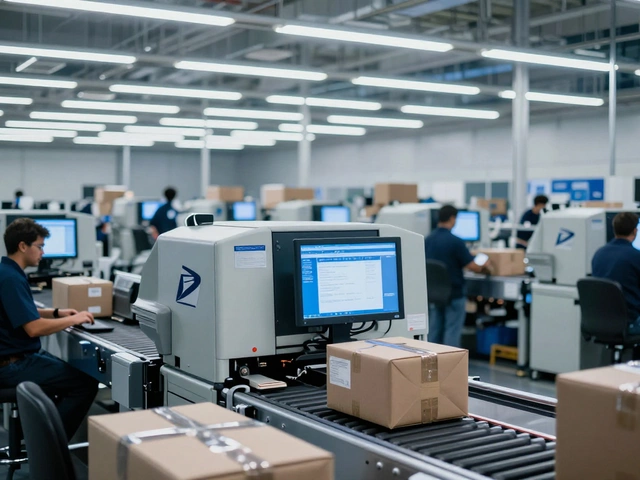Ever wondered why some warehouses just seem to run smoother than others? One big reason is SAP. It’s not a new kind of scanner gun or a robotic forklift—it’s the brains behind a bunch of warehouse magic. In plain English, SAP is software that helps people keep track of everything coming in, moving around, and shipping out. With so much stuff rolling through modern warehouses every hour, using spreadsheets and paper just isn’t going to cut it anymore.
People hear about SAP all the time in business, but most don’t get what it really does in a warehouse. If you’re dealing with stock-outs, lost inventory, or piles of paperwork, SAP is basically purpose-built to make all that far less stressful. It connects everything from incoming deliveries to outgoing shipments and links up departments that always seem out of sync. The result? Fewer surprises on the warehouse floor, faster order packing, and instant info when customers ask where their shipment is.
You can think of SAP like a warehouse command center. Want to know exactly how many red widgets are sitting in aisle 7? It’ll tell you—without you sprinting over there. Need to spot packing mistakes before boxes leave the building? SAP flags them right in the system. Even better, it makes audits and inventory counts way less painful. Stick around, because you’ll want to see just how much easier warehouse life can be once SAP jumps into the mix.
- What Does SAP Mean in a Warehouse?
- Core Features: Not Just Counting Boxes
- Real-World Impact: How SAP Shapes Warehouse Life
- Tips for Getting the Best Out of SAP
- Common Problems and Quick Solutions
What Does SAP Mean in a Warehouse?
In the warehouse world, SAP is pretty much a heavy hitter. It stands for Systems, Applications, and Products in Data Processing—a mouthful, but don’t let that throw you. Basically, SAP is world-famous business software that helps companies track, control, and speed up whatever goes on inside a warehouse. It's not just one thing, either; it’s a whole set of tools designed to link what’s happening on the rack to what’s happening in the office. If you buy something from a big retailer, there’s a good chance SAP helped get it from the warehouse to your door.
SAP’s most-used module for warehouses is SAP Warehouse Management (WM) or the newer SAP Extended Warehouse Management (EWM). These modules help organize and track things like where products sit, which orders are urgent, and how to move stuff with less hassle. It works with barcodes, RFID, and even robots—so everything and everyone speaks the same digital language.
You can see SAP’s impact in some real numbers. Big companies lean on it because it slashes errors and speeds things up. According to a 2023 survey by Gartner, over 60% of global companies with complex supply chains use SAP modules to run their warehouses. Here’s how warehouses stack up with SAP vs. old-school manual methods:
| Warehouse Task | Typical with Manual Process | Typical with SAP |
|---|---|---|
| Inventory Accuracy | 85% | 98%+ |
| Order Picking Speed | 160 orders/day | 250 orders/day |
| Lost Items per Month | 17 | 2 |
| Fulfillment Error Rate | 5% | 1.2% |
So, what does actually using SAP look like? Imagine logging into a screen, scanning new deliveries, and having everything instantly synced—no more guessing. You’re not just tracking stock, you’re getting alerts, automated pick lists, and even help deciding where to store new items for faster picking next week. That kind of clarity means managers can spot holdups before they become disasters, and staff spend less time searching for missing inventory.
At the end of the day, SAP is the nerve center for busy warehouses. It connects the dots from the warehouse floor all the way to the accounting team. Whether you run a massive e-commerce operation or a single storage building, SAP means fewer headaches and a winning edge on speed and accuracy.
Core Features: Not Just Counting Boxes
If you think SAP just logs inventory, you’re missing the point. This software covers much bigger ground in the warehouse. It brings together everything from receiving goods to managing how things are stored, picked, packed, and shipped. Instead of flipping between different programs or paper logs, you see everything in one place.
Here are the key features that separate SAP from regular inventory systems:
- Real-Time Inventory Tracking: SAP isn’t just a logbook—it updates the second something moves. Scan a barcode, and the database instantly reflects the change. No more manual data entry lag.
- Automated Putaway and Picking: The system tells you where to stash new stock and which aisle has your next pick. Less walking, fewer errors.
- Warehouse Layout Management: SAP learns your warehouse map. It knows the fastest pick routes and the best spots for fast-moving products, so teams waste less time.
- Shipping Integration: From printing shipping labels to generating packing slips, SAP connects directly with shipping systems. What used to take minutes now happens in seconds.
- Workforce Management: Managers can assign tasks, monitor progress, and balance workloads through one dashboard. This keeps operations smooth—especially during busy seasons.
Want some numbers? Check this out:
| Feature | Time Saved Per Day* |
|---|---|
| Automated Picking | Up to 2 hours |
| Real-Time Tracking | Reduces stock-checking time by 70% |
| Shipping Integration | Cuts order processing time by 50% |
*Based on mid-sized warehouses using SAP Warehouse Management
It’s not just about counting boxes. SAP steps in to automate those boring tasks, catch errors before they cost money, and help people work smarter, not harder. When you’re running thousands—or even millions—of stock movements a month, those little features make a huge difference. Bottom line: more accuracy, less chaos, and a lot fewer headaches.

Real-World Impact: How SAP Shapes Warehouse Life
SAP changes the game for warehouses by making life less chaotic and way more predictable. When you plug SAP into daily warehouse work, things just get simpler—whether you're talking about inventory accuracy, order speed, or avoiding those head-slapping stock mistakes.
The biggest impact? Nearly every step on the warehouse floor gets tracked, updated, and checked in real time. No more guessing. For example, when a shipment comes in, SAP helps log it right away, so everyone from forklift drivers to planners knows exactly what’s available. If someone pulls stock for an order, SAP updates the count instantly—meaning less risk of double-selling or running out without anyone noticing.
Take order fulfillment speed. A 2023 study by Gartner showed that warehouses using SAP’s warehouse management systems (WMS) saw order processing times drop by an average of 28%. It’s not about racing around—it’s because SAP makes picking lists smarter and sends staff right to what they need. This reduces time spent wandering the aisles or making wrong picks.
Here’s how SAP usually shifts daily routines:
- SAP links up with barcode scanners and mobile devices, giving workers real-time info as they go.
- Supervisors can spot bottlenecks fast or see when pallets are stuck too long.
- Inventory counts can be automated, so no need for long overnight shut-downs to tally every last box.
- Lost items drop, because you always know what’s in the building and where.
Let’s look at some numbers. Here’s how warehouses typically perform after a year using SAP:
| Metric | Before SAP | After SAP |
|---|---|---|
| Inventory Accuracy | 84% | 99% |
| Order Picking Errors | 3.7% | 1.2% |
| Annual Stock Loss (% of revenue) | 1.1% | 0.3% |
| Order Turnaround Time | 8 hours | 5 hours |
A cool bonus: SAP helps with compliance and tracking recalls, which is a nightmare if you run warehouses for food or medical supplies. With SAP, pulling up batch numbers or tracking where products went is just a few clicks—not a wild paper chase.
Bottom line—real warehouses see fewer headaches, less waste, and way happier customers with SAP in the mix. It’s not perfect, but it tackles the messy stuff so people can focus on getting the job done right.
Tips for Getting the Best Out of SAP
Getting SAP to actually make your warehouse better isn’t about just installing some software and hoping for the best. You have to dive in and make it work for your workflows. Most problems happen because people try to run things the old way on a shiny new system. That’s like tossing a sports car the keys but never taking it out of first gear.
- Train everyone—seriously. Even one person who’s unsure can slow down the whole process or make expensive mistakes. Use SAP’s own e-learning tools or have a mentor in-house. In one survey, 74% of warehouse workers said they understood the system better after hands-on practice, not just lectures.
- Customize your dashboards. No two warehouses are the same, so tweak your SAP screens to show the info you really need (think: current orders, low stock warnings, late shipments). Most power users set up their own favorites to keep what matters most just one click away.
- Automate repetitive tasks. There’s no reason to manually re-enter order info or check totals all day. SAP has workflows and bots for a reason—set them up for stuff like barcode scanning, labeling, or sending out shipment notifications.
- Connect SAP to your other tech. If your scales, label printers, or conveyor systems all run separately, something will eventually mess up. Linking them through SAP cuts down errors and saves hours—especially when you’re slammed at peak season.
- Keep things updated. Outdated master data (like old part numbers or customer addresses) leads to lost shipments, incorrect picking, or annoyed customers. One big tip: schedule weekly data clean-ups. Trust me, fixing ten records regularly is way less painful than sorting out hundreds in a panic.
Here’s a quick snapshot to see how some warehouses are using SAP features smarter than others:
| Warehouse Size | Times Inventory Counts | Automation Level | User Training Hours per Year |
|---|---|---|---|
| Small (Under 20 staff) | Monthly | 20% | 12 |
| Medium (21-100 staff) | Monthly | 45% | 20 |
| Large (100+ staff) | Weekly | 80% | 32 |
Notice how bigger operations lean hard into more frequent training and automation? That’s not a coincidence. The more you let SAP take over repetitive stuff and keep training fresh, the more headaches you skip—no matter the warehouse size. Audit your own processes every quarter to spot spots where SAP can help you save time and money.

Common Problems and Quick Solutions
If you think SAP in a warehouse is magic and always smooth, think again. Even the best setups can hit snags, especially when people are new to the system or there’s too much rush. Let’s break down the most common headaches and how to fix them fast.
- SAP inventory doesn’t match what’s actually on the shelves. This pops up all the time—wrong counts, missing items, or ghosts in your reports. Usually, it’s caused by people skipping scans or doing things in the wrong order. The fix? Make sure everyone scans everything, every time, in real time. Quick daily spot-checks catch mistakes before they snowball. If your SAP system has mobile scanning, use it everywhere you can.
- Slow screens or ‘spinning wheel of death’ when booking or moving stock. SAP can drag if too many people are dumping big loads of data or the network’s sketchy. Try staggering when teams process large orders and double-check your Wi-Fi reaches every shelf and dock. Sometimes, cleaning out old data or unneeded transactions makes a big difference, too.
- Staff confusion when new updates roll out. SAP updates are supposed to help, but they sometimes change how things look or work and throw off even seasoned users. Keep simple tip sheets handy for each role in the warehouse—no one wants to flip through a giant manual. Short hands-on trainings or quick video refreshers can keep folks up to speed without wasting the whole day.
- Poor integration with things like barcode scanners, printers, or shipping software. SAP can connect to a lot of hardware, but not everything plays nice without some tuning. Before a big rollout, test how everything talks to SAP. If labels are misprinting or data isn’t syncing, check drivers and make sure each device speaks SAP’s language. Don’t wait for the holiday rush to sort this out or you’ll regret it.
One more tip: keep an SAP “go-to” person on each shift. This isn’t just the IT team—it could be anyone who really gets the system and can troubleshoot on the fly. That way, bottlenecks get fixed right away instead of piling up for the next dayshift or night crew to fight through.





